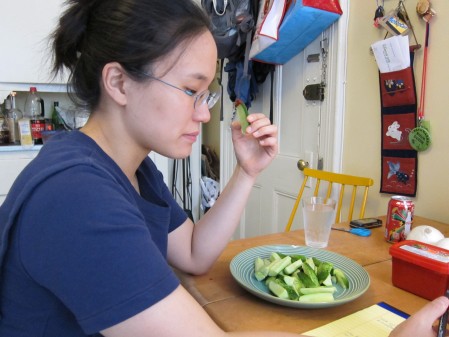
Diane and I recently started farming out recipes to friends and family, so that we could see if what made sense to us made sense to them. One of the most surprising (and “duh!”) moments for me was realizing how difficult it is to shop for Korean ingredients when you don’t read Korean. Living in New York City, they were able to find their way to HMart or Flushing easily enough. The problem was when they got there and faced a wall of ingredients with very little English on them.
Classic example of a perplexing ingredient: gochujang or 고추장, frequently translated as “hot pepper paste” or “red pepper paste.”
What is Gochujang?
This is a staple of the Korean pantry, right up there with soy sauce and doenjang, or Korean fermented soybean paste. The paste, which usually has the consistency of a thick jam, is both spicy and sweet. It goes into ssamjang, i.e., sauce for barbecued beef and lettuce wraps; it goes into soups; it goes into stir-fries; it coats the rice and noodles in bibimbap and bibimnaengmyeon. Koreans cannot live without gochujang. In fact, when my mother travels outside of Korea, she carries a little tube of it in her purse.
Traditionally, every family made its own gochujang, along with its own doenjang and ganjang, or soy sauce. Gochujang is made from fermented soybeans, similar to what’s found in doenjang, which gives both condiments that inimitable, addictive, umami flavor. (The doenjang process is long and stinky, a post in itself.) The fermented soybeans are combined with red chile peppers and a grain, either rice, sweet rice, or barley. The whole paste is then put in a clay pot and aged in the sun for about a month. You have to know your seasons and your weather — if you hit a rainy patch, it won’t work. If you’re out of town and you can’t carefully cover and uncover for optimal sun exposure, it won’t work. A woman I met told me that growing up in Florida, her mother was careful to rotate the pots from the sunny front of the house to the back. You have to tend the gochujang as tenderly as you would age a cheese or a prosciutto. Which makes it even more amazing that it’s something every family, every Korean mother, knew how to do.
That’s no longer true. Most Koreans now live in high-rise apartments, which doesn’t really foster clay-pot fermentation. When my sister and I lived at home, my mom made her own gochujang, but now that we’re gone, even she’s given up on making her own.
My mother now has mysterious sources “in the country” from which the gochujang comes back so strong it kicks like a mule. Even outside Korea, in places like New Jersey, I hear rumors there are grandmothers making a little extra money selling homemade gochujang. But for those without sources, the only option left is the Korean grocery store.
Which brings me to the main point of this post: what is the best commercially made gochujang?
And equally importantly, how can you identify it?
Identifying Gochujang
First, in this post, I am talking about gochujang, and not ssamjang or chojang, both of which are sauces made in part with gochujang. The packaging is normally red, and if there is no English on the front label, the white import label on the back should say in English “hot pepper paste” or “red pepper paste.”
Second, learn to read Korean. Just kidding. (It is really easy, though.) What I do mean to say, though, is try to learn what the major brands and labels look like, even if they only use Korean letters. Wang is always written in the Roman alphabet as “Wang.” Chung Jung Won’s logo is a small multi-colored abstract landscape in a white square:

While Haechandle is a red rectangle with the name of the company and a jaunty slash.

The Taste-Test

Diane and I decided to test six types of gochujang, all bought in standard Korean grocery stores in New York. We sat down with all six tubs and a plate of cucumber sticks to dip in them.
I cannot say that we tested them blind, or that we were careful to thoroughly cleanse our palate after each one. Nor can we claim special expertise in gochujang flavor. There is no science to our methods.
But we do have our impressions and some useful explanations, I think, of what some of these tubs of paste proclaim. We had a hard time saying, “This is definitely the best!” but we did agree on which ones we liked better and which ones we liked least.
They ranged in price from $4.99 to $7.99, with some containers larger than others. We didn’t factor the price heavily into the taste test because the paste lasts forever, and a couple extra bucks for a better-tasting gochujang is money very well spent.
So here they are, more or less in order of least liked to most liked:
6. Brand: 쳥정원 (Chung Jung Won) O’Food, Organic
Special Claims: 순창 (Sunchang), meaning from the city of Sunchang, which is famous for its gochujang. Organic.
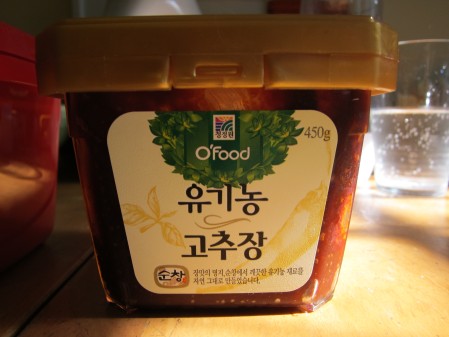
Despite the romantic lighting and the allure of “organic,” this was emphatically our least favorite. It was pastier and grittier than the other ones, and it tasted primarily salty, neither sweet nor hot.
5. Brand: Wang
Special Claims: 찹쌀고추장 (chapssal-gochujang), meaning made with sweet rice. It normally has a deeper, sweeter flavor, and was more expensive for having been made with expensive sweet rice. Now, it’s a signifier for extra special and delicious.
한국산 (hanguksan), meaning made in Korea, which is very important to Koreans for reasons that include nationalism, a belief in terroir or the flavor that comes from place, and fear of low-quality Chinese food, i.e., plastic.
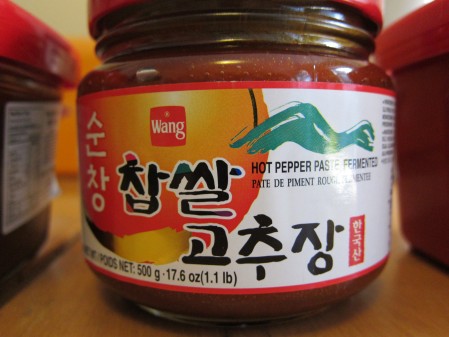
This one was very smooth, but it was a little too sugary and sweet, to the point of being almost mild. Maybe “boring” is more accurate. We were not surprised to find out afterward that this one contained MSG.
4. Brand: Wang
Special Claims: 태양초 (taeyangcho), meaning the peppers were sun-dried, which makes for better flavor but is also more expensive. Also 찰고추장 (chalgochujang), which is the same thing as chapssal-gochujang. Made in Korea.
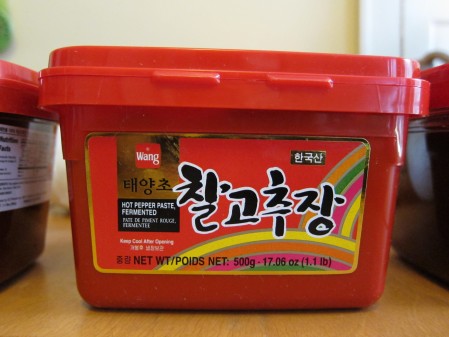 The sun-dried option from Wang didn’t impress us any more than the none sun-dried one. It was also on the sweet side and although it was smooth, it also tasted a bit flat. It was spicy yet without real heat, and again, we were not surprised to find out it contained MSG.
The sun-dried option from Wang didn’t impress us any more than the none sun-dried one. It was also on the sweet side and although it was smooth, it also tasted a bit flat. It was spicy yet without real heat, and again, we were not surprised to find out it contained MSG.
The last three, Diane and I disagreed about which ones we liked best, but we agreed they were all quite nice.
3. for Grace, 1. for Diane Brand: 해찬들 (Haechandle)
Special Claims: “All Korean Hot Pepper.” The back label is even more emphatic, breaking down the different ingredients and proclaiming each to be from Korea.
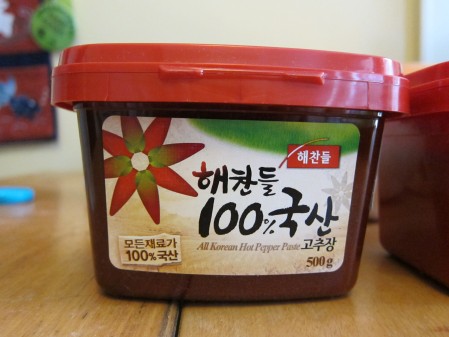
This one was really spicy, with a graininess that felt homey rather than off-putting. Diane felt the flavor of hot peppers really came through and we both agreed there was a cleanness that was very appealing. For me, though, that cleanness meant it lacked depth. Still, a very good, proper gochujang.
2. for both of us. Brand: Haechandle
Special Claims: 청양초 (cheongyangcho) refers to the use of a particular, very hot pepper similar to jalapeno. In case you were wondering, this pepper makes the paste 재대로 매운 or “Appropriately Hot.”
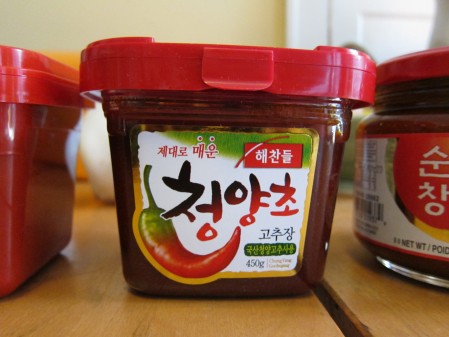
We both wondered if we were unduly influenced by the vibrant picture of the ripening chile pepper on the label, but we liked the fresh spiciness of this one very much. It was a bit sweeter and saltier, as well as hotter, than the other Haechandle gochujang we tried.
1. for Grace, 3. for Diane. Brand: 청정원 (Chung Jung Won)
Special Claims: THE WORKS. Made in the city of Sunchang, sun-dried, made with sweet rice, which you must not forget is “our rice,” a.k.a. one hundred percent Korean, baby!
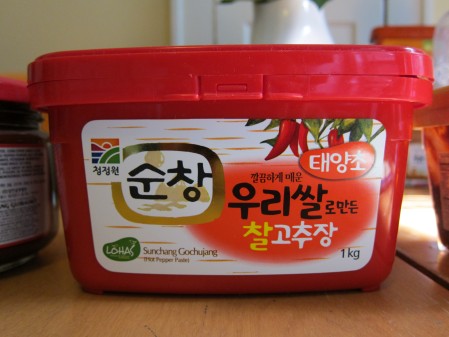
I liked this very much. I thought the flavor was lovely, dark and deep (though I have no promises to keep, heh). It was also less sweet, which I prefer, because I can then add sugar to taste. Diane agreed it was not too sweet and quite good. I may have been unduly influenced by the prominent promise that it was made in Sunchang. Diane and I stopped there on our last trip to Korea, and it was so exciting, I am going to have to write a separate post about it.
So what does all this add up to?
Your local Korean grocery store may not have these exact types and brands. We had two from Wang, two from Haechandle, and two from Chung Jung Won. Each brand makes more types, and there are at least one or two other major brands out there as well. We can’t say we tested the most “typical” ones as the selection can really vary from store to store. These are some that are available online.
But we do think there are some lessons to take away from this somewhat unprofessional taste-test.
- Haechandle and Chung Jung Won are good, decent brands.
- The words Sunchang (the city), taeyangcho (sun-dried), and chalgochujang (sweet rice gochujang) imply quality, but they don’t guarantee it.
- To some extent, “the best gochujang” is a matter of personal preference. For me, less sweet is very important. For you, the sweetness might be a plus.
- Yet in the end, no gochujang will fail you. The quality of the gochujang can turn a stew from a good stew to a great one. But none of these would have made a bad stew. They were all pungent, salty, spicy, and sweet, adjectives that all add up to tasty in my book.
- So don’t be paralyzed by the choices! Take a chance, take one home, and try it.
And if you ever do get a chance to taste some homemade gochujang, go for it. It may not be exactly what you like best, but there will be a character to it that you will never find in one of these plastic tubs.





















































